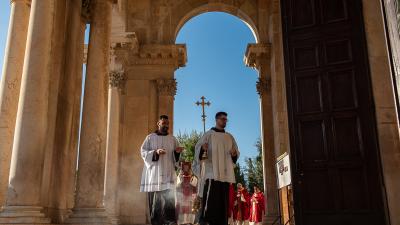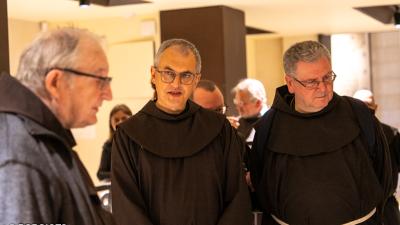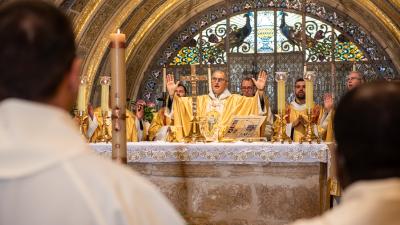
On November 2, as per tradition, All Souls Day was celebrated: this is the day that the liturgy reserves for life after death and focuses on eternal life. Also, in Jerusalem, this day is dedicated to the visiting the dead and the blessing their graves in the cemeteries located on Mount Zion.
For the friars of the Custody who were present in Jerusalem, the celebration was divided into three different parts: the morning celebration in memory of the deceased Franciscan friars, that of mid-morning for the deceased parishioners and the third for foreigners, a celebration aimed at the deceased faithful buried in Jerusalem, who do not have family members or whose family members could not take part in the day’s liturgy.
After the parish celebration at St. Savior’s, led by the Kawas and lulled by the songs of the faithful and the Franciscan friars, the crowd present at St. Savior’s Church, processed toward the cemeteries. The first to be visited and blessed was that of the Franciscan friars, followed by the cemetery for foreigners and, finally, the one for parishioners.
This was an act of unity with the universal Church and beyond: it was a celebration that unites all three monotheistic religions present on the land of the Holy City. “Death unites everyone in the resurrection,” said Br. Nerwan Al-Bannah, the parish priest of St. Savior’s Church in Jerusalem. “Today is a Christian feast, but all Muslims and Jews [also] believe in the resurrection. Therefore, this means that this day does not have a value only for the parish church: it is a day of unity for Jerusalem.” During his homily, the parish priest recalled two essentials in order to fully live out this ancient tradition: faith, to welcome all that Jesus said, and hope, to overcome sadness and trust in the certainty that one day we will all meet again in the Heavenly Jerusalem.
Several parishioners came to pay homage to their loved ones. They came from the Old City of Jerusalem, Beit Hanina, Beit Fage and Beit Safafa and even more those who will come during the three days that the cemeteries are open to bring flowers, candles or incense to the graves, or even sometimes to share some sweets with neighbors and family members. “Sweets,” said Fr. Nerwan, “in all cultures is a symbol of joy and sharing. The faithful prepare and eat them because they know that their loved ones are alive and therefore they are joyful because death unites everyone in the resurrection.” This feast has the sweet taste of eternity.
Giovanni Malaspina




